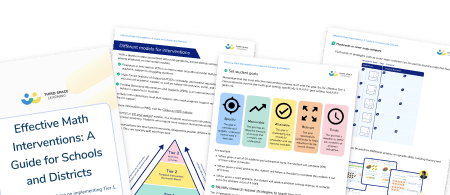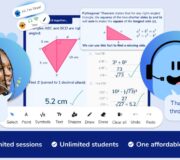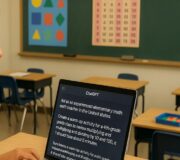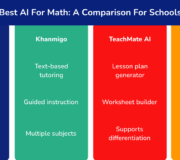How to Support Children with Autism in the Classroom: 3 Easy to Implement Strategies for Teachers and School Leaders
As part of our own endeavours to better support children with autism in our online math intervention, we’ve asked special educational needs teachers and autism spectrum specialists Sarah Loveridge and Lynn McCann to give some practical advice on what we can all do to support a child with autism in the classroom.
As an autism specialist teacher, one of the most common issues I come across is children struggling to work independently. Most autistic students are capable of working at age-related expectations (side-note, some of them actually thrived at home over lockdown) but for a variety of reasons, they struggle to ‘perform’ in mainstream classrooms. This begs the question of how to support a child with autism in the classroom.
Effective Math Interventions: A Guide for Schools and Districts
Looking to empower students with autism and help them thrive in the classroom? Download our guide for school leaders, administrators, and interventionists on implementing successful math interventions.
Download Free Now!Our goal: independence and resilience
Unfortunately, often the go-to support strategy is to sit them next to a 1-2-1 TA who ends up doing most of the work for them, which can result in further lack of motivation, independence and resilience.
Don’t get me wrong, some children really do need constant support and I am in no way trying to belittle or demean the work of all the wonderful carers, TAs (and teachers) out there supporting children, doing their best to create a positive learning environment and help autistic children succeed. You’re all great and you hold schools together – we know this.
But what is increasingly common (with expectations for both children and teaching staff becoming increasingly unattainable) is that we, as the adults, also have a fear of failure when trying to support children’s learning.
If they don’t do enough work, our work ethic is scrutinised. If they don’t answer all the questions, our ability is questioned. If they lack motivation, our motivations must be lacking.
My three key strategies for supporting children with autism
When you read these suggested teaching strategies please know that they are written from a place of understanding and empathy. They are options, advised tactics, and potential ideas to meet a child’s needs that you can keep in your toolbox which may work some days but not on other days.
They may work wonderfully for Child A but get Child B absolutely nowhere. We know that the autism spectrum is broad and is never one-size-fits-all but hopefully some of these strategies will at least start a conversation about how we can effectively support autistic learners in mainstream schools.
You’ll note that in this article we have avoided referring to autism spectrum disorder (ASD) or developmental disorders as we prefer a more strengths based approach.
It’s also worth noting that there are plenty more strategies I could mention but in order to give some depth, clarity and detail I’m just going to talk about three biggies with a focus on developing independence. Let’s get to it!

Meet Skye, the voice-based AI tutor making math success possible for every student.
Built by teachers and math experts, Skye uses the same pedagogy, curriculum and lesson structure as our traditional tutoring.
But, with more flexibility and a low cost, schools can scale online math tutoring to support every student who needs it.
Find out more
1. Consider the environment in your classroom carefully
Mainstream schools are full of distractions, especially related to sensory stimuli. We often assume that a colorful, busy environment implies fun and creative working – but for a lot of autistic children and children with developmental disabilities, this can actually lead to sensory overload.
Fluorescent lights, loud bells, uncomfortable seats and restroom hand dryers are all contributors to sensory stimulation.
This sensory input can be very distracting so it’s worth assessing your environment carefully to pinpoint where the distraction is coming from and whether it can be avoided.
Think: Could you go around the classroom/school with your autistic child and ask them to point out sensory trigger points? This is a great way to build your own general autism awareness and start to see things from the child’s perspective.
Top tips
- Ear defenders or putting music on may help to drown out some other auditory distractions.
- A stability cushion or weighted blanket over their legs may help them feel grounded and calm, enhancing their ability to focus.
- Sitting alone or further apart from others may be useful, especially if they are uneasy in social situations or just have a chatty or fidgety table partner!
Action: A flexible workstation
One way to cut out some visual distractions while in the classroom is to put up a privacy screen around the edge of their table to create a workstation. Cardboard is perfect for this.
The great thing about these is their flexibility. Need it for independent working in math? Put it up. Don’t need it during group work in English? Take it down.
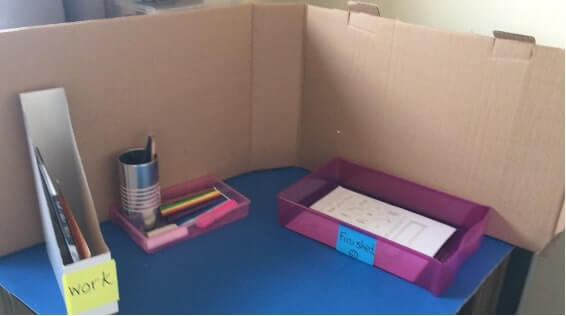
If you want it to be a more permanent fixture then of course you can leave it up on their own table but it’s nice to have the option. This can be especially helpful in continuous provision: if the workstation is up, it’s time for a focused task.
You may want to personalize the workstation with the child’s name or a couple of pictures but don’t let the workstation get too cluttered. Only get out the resources they need for that lesson – you don’t need every workbook, word mat and WAGOLL on display all the time. Cut out the clutter and keep it simple, otherwise, it may become a distraction in and of itself!
All of these strategies are best done with the child. Please don’t suddenly set it up one Monday morning as a “surprise” and expect them to be overjoyed!
Autistic children appreciate predictability and often find change difficult, due to their underlying anxiety and need for time to process the changes.
If you suddenly present them with a workstation out of the blue, they may end up confused, and worried and might even feel like it’s a punishment for not working hard enough.
Talk about it with them first and explain that you’re going to give it a go to see if it helps them focus. It might help to show them pictures of adult workstations so they recognize that it’s a lifelong strategy that they can use.
What we’re doing at Third Space Learning
Many children with autism find that the one-on-one environment of our AI math tutoring is very conducive to learning math. This is partly because their personal AI tutor, Skye, can work at the child’s pace, and won’t rush them through a concept.
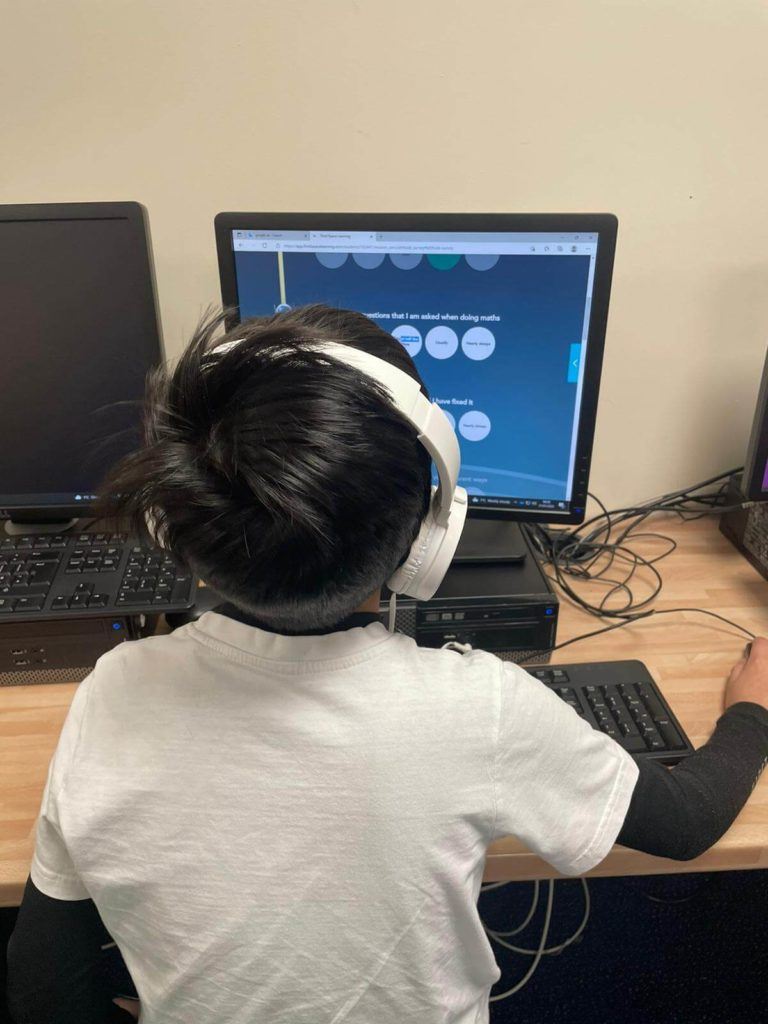
Children wear headsets as a matter of course in the lessons and these effectively zone out any classroom distractions around them. Generally, schools who use our AI tutoring will book the computer lab to enable them to have up to 20 of their target students taught together at once.
2. Chunk the school work and provide work schedules for autistic children
I don’t know about you but I have a list for just about everything: chores, holiday packing, meal ideas – you name it, I have a list for it. Why do we do it? Often, it’s because our brain appreciates us breaking things down into smaller chunks.
It helps us to process what needs doing, things seem more manageable and we get a sense of achievement every time we cross something off. Our aim with the next strategy is to do the same thing with school work.
Children are often given worksheets full of information or questions and it can be difficult for them to know which bit to focus on first or how to process it all effectively.
By breaking it down with visual aids, we’re giving autistic children something to refer back to, thus building independence as you point them back to the visual (instead of repeating an instruction a hundred times).
Action: Visual work schedules
These are easy to adapt and personalize for any child with autism depending on their interests, age and ability. The aim is simple: complete short, manageable tasks to work towards a quick, motivational reward.
Keep it visual and work with whatever attention span the child has in order to tick things off. Rather than trying to push them through a big long list of tasks, the work schedule breaks it down into short bursts of productivity with regular breaks in between, supporting them with that visual reminder.
Example 1: preschool work schedule
I used a work schedule with a preschool student who struggled to process more than one instruction at a time. We started with one instruction = reward and over time we built it up to following two instructions = reward and so on. It requires patience but can lead to greater independence, especially if the child is involved in setting out the steps.
Example 2: 1st grade work schedule
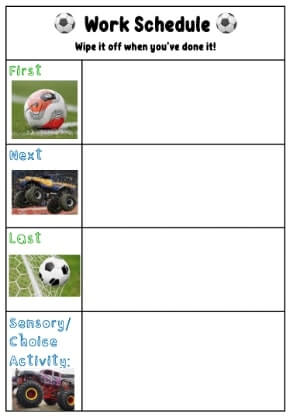
The above example is for a child in 1st grade who initially loved monster trucks and football! After two weeks of using this, he decided that actually he loved Minecraft more than anything else in the world. No problem – we simply stuck pictures of Minecraft over the other photos and the work schedule was back in business.
This child was able to manage 2 or 3 tasks before getting a quick reward. He still needed lots of modeling and scaffolding to begin with but, over time, as he became more comfortable and familiar with it, his independence grew.
Note: the reward doesn’t have to be time-consuming or lots of extra work for you. I worked with a kindergarten child who loved those little pop-up toys so for her this was a super motivational reward.
After initial reluctance, we wrote all our numbers to 15 and read a whole reading book in 20mins just by using a 1-step work schedule with the pop-up toy as a reward each time.
Example 3: 5th grade work schedule
This third example was used with a child in 5th grade who loved the NYPD. When I went back for my first visit after giving them the work schedule, his unfiltered honesty shone through as he told me straight up “oh, we never use that!”
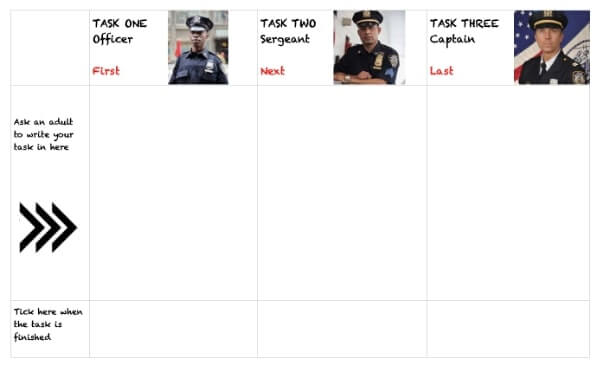
I discovered that he was being asked to get through all of his morning challenge, all of English, and all of math before he got a reward. This is just too much!
We want to use this resource to break everything down into little chunks so that the reward is always within reach.
Waiting almost 3 hours for a reward may be attainable for children who are already pretty independent or have used a work schedule for a while but as a first step, it was too big a jump.
For this child, it was also helpful to give him some rules for the reward so that it wasn’t distracting and difficult for others around him. He chose to play a game on the iPad as his reward so we agreed on the rules with him and stuck them on his table.
Again, visual support and an active discussion helped this strategy to succeed. We don’t want children to feel confused or out of control, these strategies are supposed to help them!
What we’re doing at Third Space Learning
The fact that our one-on-one online sessions take place at the same time every week allows us to be fitted into a work schedule for an autistic child. They can also be confident that they will always be learning math with the same AI tutor, Skye, who is trained to use best practice for students with neurodiversity.
All upcoming topics are visible to the class teacher who can inform any child what they will be learning each week. Moreover, the AI tutor will always start a lesson with the same format ‘Today we are going to be learning about …..’ this helps to ground students in their one-on-one.
Our platform alerts Skye when a student has special educational needs, and draws on an actionable blurb on how to adapt the lesson before it starts.
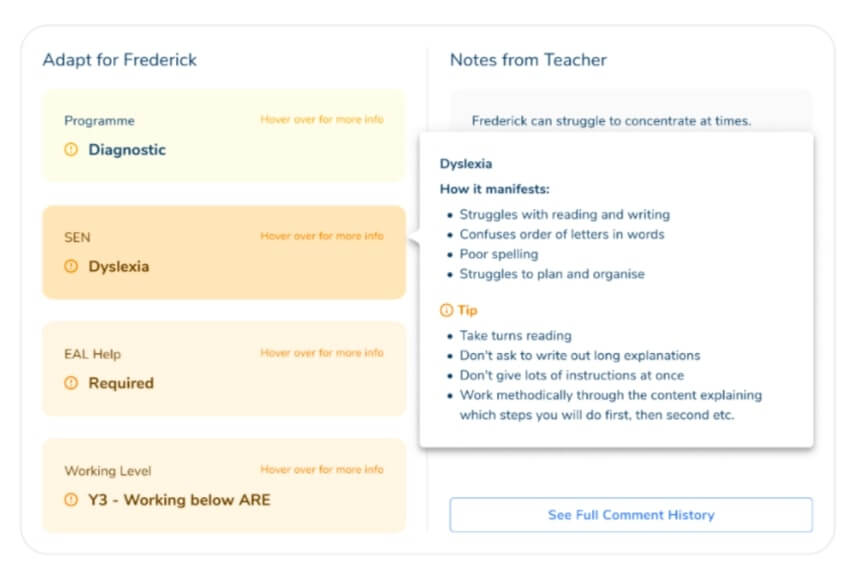
3. Actively support children with autism with planning and organization
One thing that can hinder independence is not having the right thing at the right time when working with the whole class.
The child with autism in your classroom may be very capable of writing 3 sentences in one go…if only they could find their pencil.
Or maybe your child could sit and focus for the whole lesson on their math problems…if only they knew where their worksheet was.
One of the benefits of using these classroom strategies is that we’re not only getting work done (hopefully!), but we’re also teaching young people life skills.
If they are able to organize themselves and independently find the relevant equipment/worksheet, then they’re well on the way to being successful in life, as well as reaching their potential academically.
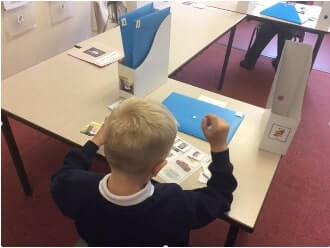
Action: Workstation + work schedule
I’ve found the best results in improving an autistic child’s organization is to combine the benefits of the workstation and the work schedule. There are several options for how you can go about this:
- Laminate the work schedule and stick it up on one of the workstation walls.
- Cut the work schedule into strips and put each strip in an envelope for children to open.
- Use some magazine folders or trays labelled ‘to do’ and ‘done/finished’. This helps children to stay organized, gives a focus/purpose to the task and also helps them feel a sense of accomplishment as the work moves from one tray to another throughout the lesson or day.
- Add a timed element: for some children instead of saying “task one: complete math question one” it might be more helpful to say “task one: work on math for 2 mins”.
Using a timer really gives children something to aim for, especially if you know that they’re going to really struggle to complete math question one without any support from you.
After their 2 minutes of trying independently, then you can go and help them – but we’re still teaching students resilience by encouraging them to have a go on their own first.
What we’re doing at Third Space Learning
The online lessons always follow a similar, well-researched and pedagogically-sound structure, and Skye is trained to signpost to students at each stage what is expected of them.
After the learning slides, they take a similar approach to the ‘I do, we do, you do’ that children will be familiar with from class by using ‘follow me’, ‘your turn’ (scaffolded) and ‘you do’ (support as needed).
Indeed, Skye uses simple and concise language to break down the problem, explain the steps, avoid vague terms, and doesn’t use too many open-ended questions.
Bonus strategy: Rewards!
We are all motivated by rewards, and as with adults, you’ll find that the same rewards don’t work for all autistic children. As part of getting to know the children in your class, you’ll soon find out what it is that the child with autism is interested in and use this to encourage them to take ownership of the strategies above.
Note: if your child is non-verbal and avoids eye contact you can still ask them what they would like! Use visuals to support communication and still seek to include them in these decisions.
List of rewards for supporting children with autism in the classroom
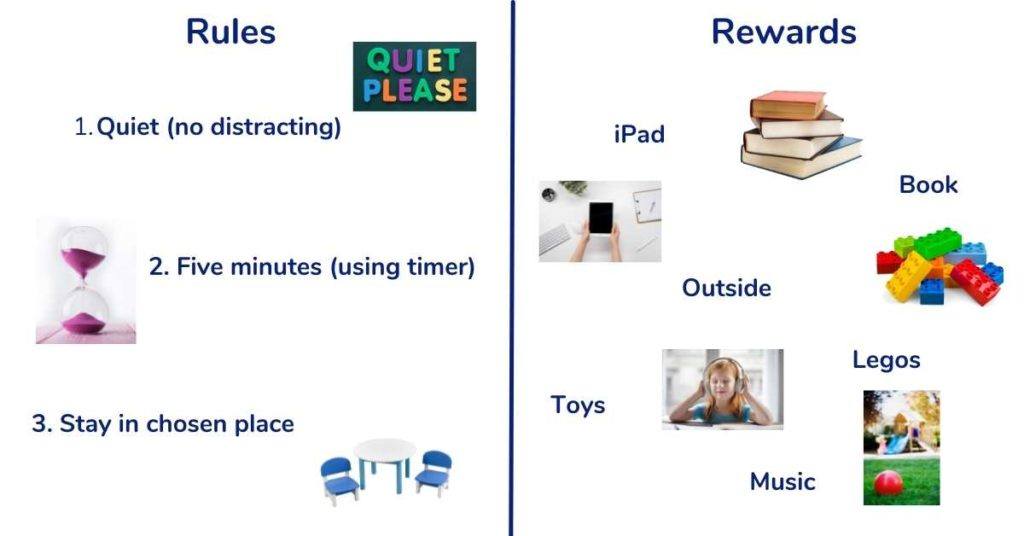
Here are 8 ideas for quick, motivational rewards that may help you to help your child – find the one that works for them. They are neither expensive nor onerous but quite often are what will make the difference!
- Pop up toy – as mentioned before – a winner with several of the children I work with.
- Sensory items – helpful for those kids who have sensory needs anyway – this helps keep their body alert in between work periods. Note: be careful that you don’t withhold these from children that need them to stay regulated during the day! They are more necessary for some children than others.)
- iPad – simple yet effective. Decide rules together about what games they can play, whether they need to use headphones, etc
- Book – some kids will love retreating to the book corner for 5 mins – rewards can be educational too!
- Music – this can be a really lovely way for kids to de-stress if they can listen to a soothing piece of music or their favorite song in between tasks.
- Sip of water – yes – it can be this simple! This may be good for those kids who want/need to stretch their legs or have a wriggle – let them walk to the water fountain in between tasks.
- Lego – if children are only allowed to build for 1 or 2 mins in between tasks why not challenge them to see how much they can build by the end of the day? This can be a very satisfying and motivating way to get work done.
- Drawing/coloring – lots of children find the mindfulness coloring sheets very therapeutic and relaxing. This can be especially beneficial to their mental health if they’re finding the work stressful and difficult.
What we’re doing at Third Space Learning
Children love the rewards we provide at Third Space Learning, as they thrive on praise and encouragement. Rewards for effort as much as for outcome are intrinsic to our online tutoring ethos as Skye is trained to develop a growth mindset.

As with the steps suggested above, the tutoring is always most successful where a child can understand the value of the lessons and how they are best able to tackle the different mathematical concepts covered.
This is often supported by visual aids to help students understand an abstract word problem, more concretely, for example, by using diagrams, graphs etc.
Read more: how to develop metacognition
It will take time…
As always, remember that it will take time for both you and your autistic child or any child with a developmental difference to get used to these strategies. While you’re starting out keep explaining to the child what you’re hoping to get out of it, and explain that you’re doing it together.
Getting them on board is key to the success of these strategies. Building independence isn’t easy but it’s such a vital life skill so keep going! You’ve got this.
Read more:
- Covid Impact on Teaching
- Dyscalculia In Schools: A Guide To Identifying And Supporting Pupils
- Differentiation in Teaching
- ADHD In The Classroom
Do you have students who need extra support in math?
Skye—our AI math tutor built by experienced teachers—provides students with personalized one-on-one, spoken instruction that helps them master concepts, close skill gaps, and gain confidence.
Since 2013, we’ve delivered over 2 million hours of math lessons to more than 170,000 students, guiding them toward higher math achievement.
Discover how our AI math tutoring can boost student success, or see how our math programs can support your school’s goals:
– 3rd grade tutoring
– 4th grade tutoring
– 5th grade tutoring
– 6th grade tutoring
– 7th grade tutoring
– 8th grade tutoring
The content in this article was originally written by ADHD specialist teachers Sarah Loveridge and Lynn McCann and has since been revised and adapted for US schools by elementary math teacher Christi Kulesza.



